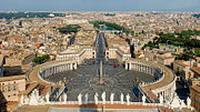Login form
THE ANCIENT ROME

Rome is the capital city of Italy and of the Lazio region, as well as the country's largest and most populous city. The metropolitan area has a population of about 4 million. It is located in the central-western portion of the Italian peninsula, where the river Aniene joins the Tiber.
The city of Rome was founded by the twins Romulus and Remus on April 21, 753 BC, and archaeological evidence supports the theory that Rome grew from pastoral settlements on the Palatine Hill built in the area of the future Roman Forum, coalescing into a city in the 8th century BC.
The city developed into the capital of the Roman Kingdom (ruled by a succession of seven kings, according to tradition), Roman Republic (from 510 BC, governed by the Senate), but finally the Roman Empire (from 27 BC, ruled by an Emperor); this success depended on military conquest, commercial predominance, as well as selective assimilation of neighboring civilizations, most notably the Etruscans and Greeks. From the foundation of Rome in 753 BC, the City of Rome was undefeated militarily (though losing occasional battles), until 386 BC, when Rome was occupied by the Celts (one of the three main Gallic tribes), and then recovered by Romans in the same year. Livy, Book 5. According to the history, the Gauls offered to deliver Rome back to its people for a thousand pounds of gold, but the Romans refused, preferring to take back their city by force of arms rather than ever admitting defeat.Roman dominance expanded over most of Europe and the shores of the Mediterranean sea, while its population surpassed one million inhabitants. For almost a thousand years, Rome was the most politically important, richest and largest city in the Western world, and remained so after the Empire started to decline and was split, even if it ultimately lost its capital status to Milan and then Ravenna, and was surpassed in prestige by the Eastern capital Constantinople. One of the symbols of Rome is the Colosseum (70-80 AD), the largest amphitheatre ever built in the Roman Empire. Originally capable of seating 60,000 spectators, it was used for gladiatorial combat. The list of the very important monuments of ancient Rome includes the Roman Forum, the Domus Aurea, the Pantheon, Trajan's Column, Trajan's Market, the several catacombs area, the Circus Maximus, the Baths of Caracalla, Castel Sant'Angelo, the Mausoleum of Augustus, the Ara Pacis, the Arch of Constantine, the Pyramid of Cestius, and the Bocca della Verità.The historical centre ville is dominated by the traditional "Seven hills of Rome": the Capitoline, Palatine, Viminal, Quirinal, Esquiline, Caelian, and Aventine hills. The Tiber flows south through Rome, with the city centre located where the midstream Tiber Island facilitated crossing.Large parts of the ancient city walls remain. The Servian Wall was built twelve years after Gauls' sack of the city in 390 BC; it contained most of the Esquiline and Caelian hills, as well as the whole of the other five. Rome grew out of the Servian Wall, but no more walls were constructed until 270 AD, when Aurelian began building the Aurelian Walls. These were almost twelve miles (19 km) long, and were still the walls the troops of the Kingdom of Italy had to breach to enter the city in 1870.The old city center contains about 300 hotels and 300 pensioni, over 200 palaces, 900 churches, eight of Rome's major parks, the residence of the President of the Italian Republic, the houses of the Parliament, offices of the city and city government, and many monuments. The old city also contains thousands of workshops, offices, bars, and restaurants. Millions of tourists visit Rome annually, making it one of the most visited cities in the world.
One of the symbols of Rome is the Colosseum (70-80 AD), the largest amphitheatre ever built in the Roman Empire. Originally capable of seating 60,000 spectators, it was used for gladiatorial combat. The list of the very important monuments of ancient Rome includes the Roman Forum, the Domus Aurea, the Pantheon, Trajan's Column, Trajan's Market, the several catacombs area, the Circus Maximus, the Baths of Caracalla, Castel Sant'Angelo, the Mausoleum of Augustus, the Ara Pacis, the Arch of Constantine, the Pyramid of Cestius, and the Bocca della Verità.The historical centre ville is dominated by the traditional "Seven hills of Rome": the Capitoline, Palatine, Viminal, Quirinal, Esquiline, Caelian, and Aventine hills. The Tiber flows south through Rome, with the city centre located where the midstream Tiber Island facilitated crossing.Large parts of the ancient city walls remain. The Servian Wall was built twelve years after Gauls' sack of the city in 390 BC; it contained most of the Esquiline and Caelian hills, as well as the whole of the other five. Rome grew out of the Servian Wall, but no more walls were constructed until 270 AD, when Aurelian began building the Aurelian Walls. These were almost twelve miles (19 km) long, and were still the walls the troops of the Kingdom of Italy had to breach to enter the city in 1870.The old city center contains about 300 hotels and 300 pensioni, over 200 palaces, 900 churches, eight of Rome's major parks, the residence of the President of the Italian Republic, the houses of the Parliament, offices of the city and city government, and many monuments. The old city also contains thousands of workshops, offices, bars, and restaurants. Millions of tourists visit Rome annually, making it one of the most visited cities in the world.

